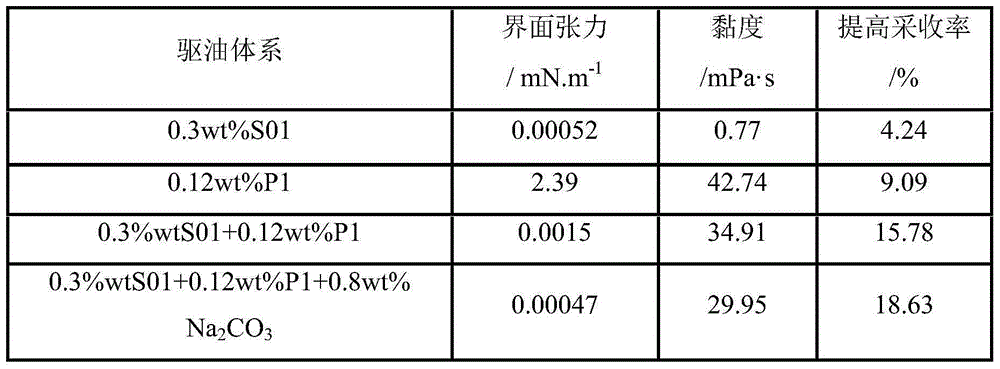Oil displacement composition containing polyether carboxylate surfactant and preparation method thereof
A technology of surfactant and polyether carboxylate, which is applied in the direction of drilling compositions, chemical instruments and methods, etc., can solve the problems of high preparation cost, high temperature resistance and high salt performance of oil displacement compositions
- Summary
- Abstract
- Description
- Claims
- Application Information
AI Technical Summary
Problems solved by technology
Method used
Image
Examples
Embodiment 1
[0056] (1) The polyether carboxylate surfactant structural formula of preparation is as follows:
[0057] Add 242 grams (1 mole) of cetyl alcohol and 8.6 grams of potassium hydroxide to a 2L pressure reactor equipped with a stirring device. When heating to 80-90°C, open the vacuum system, dehydrate under high vacuum for 1 hour, and then use Nitrogen was replaced 3 to 4 times, and the reaction temperature of the system was adjusted to 140°C and 132.0 grams (3 moles) of ethylene oxide was slowly introduced, and then 469.8 grams (8.1 moles) of propylene oxide was slowly introduced at 150°C to control the pressure ≤0.60MPa, after the propylene oxide reaction is completed, adjust the temperature to 140°C and slowly introduce 178.2 grams (4.05 moles) of ethylene oxide to control the pressure ≤0.40MPa. After the reaction was finished, lower the temperature to 90°C, remove the low boilers in vacuum, neutralize and dehydrate after cooling to obtain 998.8 grams of cetyl alcohol polyoxye...
Embodiment 2
[0063] (1) The polyether carboxylate surfactant structural formula of preparation is as follows:
[0064] Add 220 grams (1 mole) of nonylphenol, 1.5 grams of potassium hydroxide and 4.6 grams of anhydrous potassium carbonate in the 2L pressure reactor equipped with stirring device, carry out water removal and nitrogen replacement with [Example 1], the system Adjust the reaction temperature to 140°C and slowly feed 88.0 g (2.0 moles) of ethylene oxide, then slowly feed 585.8 g (10.1 moles) of propylene oxide at 150°C, and control the pressure to ≤0.60 MPa until the propylene oxide reacts After the completion, adjust the temperature to 140° C. and slowly introduce 134.2 grams (3.05 moles) of ethylene oxide to control the pressure to ≤0.40 MPa. After the reaction was finished, the post-treatment was the same as in [Example 1] to obtain 991.4 grams of nonylphenol polyoxyethylene (2) polyoxypropylene (10) polyoxyethylene (3) ether, with a yield of 97.2%.
[0065] Add 510 g (0.5 mo...
Embodiment 3
[0069] (1) The polyether carboxylate surfactant structural formula of preparation is as follows:
[0070] R 1 O(CH 2 CH 2 O) 5 (CHCH 3 CH 2 O) 4 (CH 2 CH 2 O) 20 CH 2 COONa
[0071] Among them, R 1 The carbon chain distribution is: C 12 72.3%, C 14 27.7%.
[0072] Add 195.0 g (1 mole) of mixed twelve / fourteen (C 12~14 ) alcohol, 14.5 grams of anhydrous potassium carbonate, carry out water removal and nitrogen replacement with [Example 1], the system reaction temperature is adjusted to 140 ℃ and slowly feeds 222.2 grams (5.05 moles) of oxirane, then at 150 ℃ Slowly feed 234.9 grams (4.05 moles) of propylene oxide, and control the pressure to ≤0.50 MPa. After the reaction of propylene oxide is completed, lower the temperature, and slowly feed 924 grams (21 moles) of ethylene oxide at 130°C, and control the pressure ≤0.40MPa. After the reaction finishes, with [embodiment 1] aftertreatment, must mix 12 / 14 (C 12~14 ) alcohol polyoxyethylene (5) polyoxypropylene (4) ...
PUM
 Login to View More
Login to View More Abstract
Description
Claims
Application Information
 Login to View More
Login to View More - R&D
- Intellectual Property
- Life Sciences
- Materials
- Tech Scout
- Unparalleled Data Quality
- Higher Quality Content
- 60% Fewer Hallucinations
Browse by: Latest US Patents, China's latest patents, Technical Efficacy Thesaurus, Application Domain, Technology Topic, Popular Technical Reports.
© 2025 PatSnap. All rights reserved.Legal|Privacy policy|Modern Slavery Act Transparency Statement|Sitemap|About US| Contact US: help@patsnap.com



